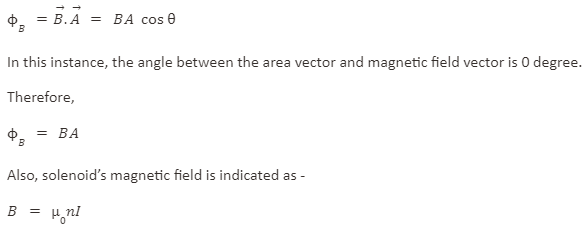The tendency of a coil to resist changes in current within itself is referred to as self-inductance. Whenever the current through a coil changes, they cause an EMF to be generated that is proportional to the rate at which the current through the coil changes. The property of self-inductance is a type of electromagnetic induction that is unique to magnetism.
According to the definition of self inductance, it is defined as the creation of an inductive voltage in a current-carrying cable when the current in the cable itself changes. It is possible for a circuit to have self-inductance if the magnetic field formed by a changing current in the circuit induces a voltage in the circuit itself. As a result, the voltage is generated by itself.
Self Induction of a long solenoid – Derivation & formula
A solenoid is a long coil of iron on which there are a large number of turns of insulated wire, which when current is conducted through it results in the production of a magnetic field. When current is carried by a coil, it has the feature of self-inductance, which is the resistance or opposition to the change in current that occurs while the current is carried by the coil. This occurs mostly as a result of the self-induced emf created by the coil itself during operation.
We’ll use the example of a solenoid with N turns, length l, and cross sectional area A as our example. It contains a current identification number (I). If B denotes the magnetic field at any point inside the solenoid, then magnetic flux indicated as –

So, the total magnetic flux () associated with the solenoid may be calculated as the product of magnetic flux through each turn and the total number of turns in the solenoid.

The above equation represents self induction of a long solenoid formula.
Note: When formulating the expression, we used the assumption that the solenoid is a long solenoid and that the magnetic field lines are continuous and straight throughout the solenoid during the calculation. A long solenoid is one that has a length that is significantly more than the radius of its cross section. The magnetic field that exists within it is constant at all times.
Application of Inductance
Inductance is commonly used to detect when vehicles are waiting at a street intersection, which is a frequent application of the technology. It has been installed in the road beneath the region where a waiting car will come to an abrupt halt by use of an electrical circuit with an inductor. The inductance of the car’s body increases, causing the circuit to change and a signal to be sent to the traffic lights, causing them to change colours.
In a similar vein, metal detectors used for airport security use the same principle. The metal detector frame has a coil or inductor that serves as both a transmitter and a receiver at the same time. The pulsed signal from the transmitter coil causes a signal to be induced in the reception coil as well. Any metal object in the route of the circuit has an effect on the self-inductance of the circuit. Metal detectors can be calibrated to detect the presence of metal on a person and can also detect the presence of metal on an object.
Conclusion
The self-inductance of a circuit is used to explain the reaction of the circuit to a changing current in the circuit. In a long solenoid, the self-inductance is determined solely by its physical properties, such as the number of turns of wire per unit length and the volume of the solenoid, and is not affected by the magnetic field or the current.
 Profile
Profile Settings
Settings Refer your friends
Refer your friends Sign out
Sign out






